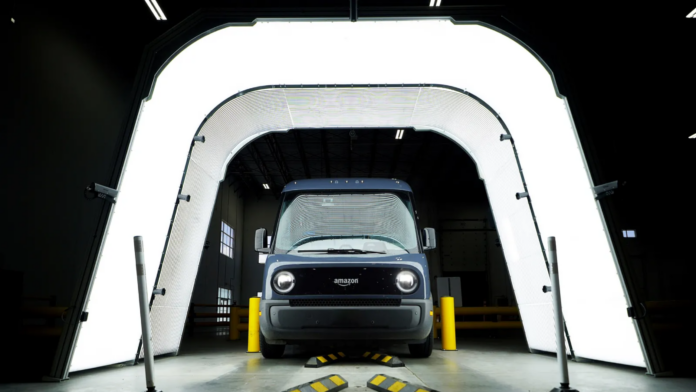The age-old process of inspecting delivery vans is undergoing a futuristic upgrade at Amazon. Picture this: drivers returning their vans are guided through advanced archways brimming with cameras. These aren’t just ordinary cameras; they harness the power of AI to capture the minutest details of each vehicle, from dents and scratches to tire quality.
How Does It Work?
The heart of this innovation is the Automated Vehicle Inspection (AVI) system. Crafted by UVeye, a dynamic startup with roots in the US and Israel, this system employs three unique high-resolution camera systems. One dives deep into a vehicle’s undercarriage, another scrutinizes tire quality, and the third zeroes in on the external facade. The resulting data melds to form a comprehensive 3D representation of the vehicle. Machine learning then steps in, analyzing this image to spot any potential damage or maintenance needs, from the smallest fluid leak to windshield cracks.
The AVI technology doesn’t just identify issues; it offers tangible time-saving benefits. As per Aziz Makkiya, Amazon’s key figure in last-mile products and services, this method trims down a standard five-minute inspection to just a minute! Considering Amazon’s massive fleet, which boasts an impressive number nearing 100,000 globally, these minutes translate into significant savings. More than just efficiency, Makkiya emphasizes the enhancement in safety the technology ensures by proactively identifying vehicle maintenance concerns.
Current Deployment and Future Aspirations
After almost two years in the testing phase, this AI-driven inspection system now graces 20 Amazon delivery stations spanning the US, Canada, Germany, and the UK. Amazon has its sights set on escalating this number in the coming years.
One noteworthy aspect is the insight Amazon gains into the operations of its Delivery Service Providers (DSPs). While drivers from DSPs traditionally oversee their vehicle inspections, this tech innovation could alter that norm. Amazon shoulders the cost for wear and tear items like tires and brakes. However, collision damages fall under DSPs’ purview. Maya Vautier, an Amazon spokesperson, assures that the tech only scans vehicle exteriors without delving into performance or utilization metrics.
The gathered data isn’t just for maintenance; it holds broader implications. Amazon can utilize it to identify consistent damage patterns linked to specific routes, thereby advising cities on road conditions or even vegetation management. Additionally, these insights could drive Amazon’s future vehicle procurement decisions or even provide feedback to vehicle manufacturers about terrain-specific issues.
The Bigger Picture
While Amazon might be one of the major players adopting AI for vehicle inspections, the concept isn’t exclusive to them. UVeye, the brain behind Amazon’s tech, has gained backing from industry giants like GM, Hyundai, Volvo, and Toyota. Other firms, like Tractable and Monk, are also making waves in the AI vehicle inspection space, signaling a shift in how the industry views vehicle maintenance and evaluations.
At the end of the spectrum, we have dealerships like Tom Wood, operating across Indiana, Kentucky, and Minnesota, employing UVeye’s technology to foster transparency. William Demaree, who helms operations there, asserts that customers, often wary of dealerships, seem to trust the unbiased, AI-led inspection process. They even engage with the tech, examining their vehicle images and snapping pictures of their undercarriages.
However, the technology isn’t without its hiccups. Demaree notes that sometimes, what the system tags as damage might be a regular vehicle feature. This feedback, though, becomes invaluable as UVeye utilizes it to refine its algorithms.
In a nutshell, with Amazon’s partnership, the vehicle inspection landscape is poised for a transformative overhaul.












